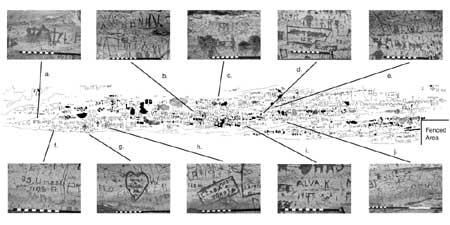MENU
|
| |
Confinement and Ethnicity: An Overview of World War II Japanese American Relocation Sites by J. Burton, M. Farrell, F. Lord, and R. Lord |

|
|
| |
Chapter 13 (continued)
Tule Lake Relocation Center
Outlying Areas
Inscriptions
There are two areas south of the developed central area that have carved Japanese-American inscriptions. One area, recorded as site CA-MOD-22, is 2 miles south of the central area on an east-facing cliff of the Peninsula (Figure 13.92). The site was originally recorded for a proposed land exchange, and is now BLM land (Gates 1982). Most of the glyphs at CA-MOD- 22 are prehistoric, but there are many historic inscriptions. The World War II-era inscriptions are within a 100 foot-long area, 5 to 10 feet above the ground. They include Japanese American names, 1942 and 1943 dates, a possible relocation center address, and one glyph reading "Tule Lake WRA Center," (Table 13.4; Figures 13.93 and 13.94). One name looks like it was done with a rotary grinder or similar tool, because the edges are smooth and deep.
Table 13.4. World War II-era Inscriptions at Rock Art Site CA-MOD-22 (all in English).
|
KUROSAWA 1/10/43 |
Figure 13.93 |
|
OKI RP TULE LAKE WRA CENTER 3/31/43 |
Figure 13.94 |
| E... MATSHI... | Figure 13.94 |
|
42 I.S. Nishimito O. ...ona |
Figure 13.94 |
| MASAU M. | Figure 13.94 |
| JACK T | Figure 13.94 |
|
TANKA 9-26-01 |
Figure 13.94 |
The other area with Japanese American inscriptions is at Petroglyph Point (site CA-MOD-1), about 3-1/2 miles south of the central area within a detached portion of Lava Beds National Monument. There are many thousands of glyphs from prehistoric through contemporary on the cliff faces (Figure 13.95). All of the prehistoric glyphs at the site were recorded in 1988 (Lee et al. 1988).

Figure 13.96. Selected World War II-era inscriptions on the cliff face at Petroglyph Point.
(click image for larger size (~78K) )
The main petroglyph area has been fenced since before the relocation center's establishment. To the north of the fenced cliff face there are some prehistoric glyphs and hundreds of modern and historic inscriptions in an area about 75 feet long. Most of the World War II-era inscriptions are located in this area, which corresponds to Panels 29 through 32 in the 1988 recording. The cliff face is so crowed with graffiti and over-writing that many individual inscriptions are difficult to read. But identifiable are a few Japanese characters, Japanese American names, 1940s dates, and relocation center addresses (Table 13.5, Figure 13.96). Some appear to have been deliberately erased.
Table 13.5. Selected Inscriptions at Petroglyph Point, Lava Beds National Monument.
| Main cliff face | ||
| Japanese | "dawn" (?) | Figure 13.96a |
| Japanese | "August" | Figure 13.96b |
| Japanese | "Inoue" (surname) | Figure 13.96b |
| Japanese? | unknown | Figure 13.96c |
| English | ...T ...TA 45 | Figure 13.96d |
| English | 43 MAXINE | Figure 13.96e |
| English | B.S. UMEZU 1105-A 2/11/45 |
Figure 13.96f |
| English | BETTY YAMASHIRO | Figure 13.96g |
| English | CLARO O. YOKOTA 1103-C |
Figure 13.96h |
| English | ALVA 1945 |
Figure 13.96i |
| Japanese | "Oyama" (surname) | Figure 13.96j |
| Japanese | "Iwashita" (surname) | Figure 13.96j |
| English | YFK 1113-D 8/2/... |
|
| English | JO 42 | |
| Detached Boulder | ||
| Japanese | "Japanese Patriot" "Japanese Empire" |
Figure 13.97a |
| Japanese | "patriotism" (color, speak, love, country) | Figure 13.97b |
| Japanese | Last syllable in the word for "Japan." | Figure 13.97c |
Near the north end of the graffiti on the cliff face there are three sets of Japanese inscriptions on a large boulder 25 feet from the cliff face. All appear to echo pro-Japan sentiments (see Table 13.5; Figures 13.97 and 13.98). Some of these inscriptions have been scratched over, as though later visitors attempted to erase them.
 Top
Top
Last Modified: Fri, Sep 1 2000 07:08:48 pm PDT
http://www.cr.nps.gov/history/online_books/anthropology74/ce13m.htm
![]()


